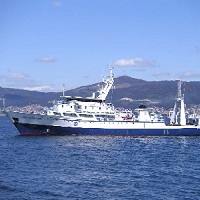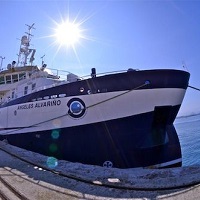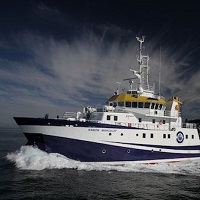Keyword
Bacteria generic abundance in water bodies
72 record(s)
Type of resources
Categories
Topics
INSPIRE themes
Keywords
Contact for the resource
Provided by
Years
Formats
Status
-

58 CTD stations performed from 10 to 5200 , depth along trhee transect om N-NW Iberian Peninsula
-

The main target of the "VULcanología CAnaria submariNA, VULCANA" project, is to study from a physicochemical, biological and geological point of view underwater volcanoes and hydrothermal systems active or not in the entire Canary basin. In addition, special attention will be given to the continuity of studies carried out in the Tagoro submarine volcano on the island of El Hierro, continuing like this, with one of the Longest physical-chemical-biological time series in the Spanish territory. The specific objectives of the Vulcana-III-0421 will be: 1.- Study of the temporal variability of physical, chemical and biogeochemical properties. a) Study of the temporal variability of temperature, salinity, pH-orp inside the crater the main submarine volcano Tagoro. b) Study of the spatio-temporal variability of thermohaline, fluorescence and oxygen fields dissolved in the hydrothermal plume of the Tagoro submarine volcano. c) Study of the spatio-temporal variability of the biogeochemical cycles of nutrients majority (nitrogen, phosphorus, silicon and ammonium). d) Evaluation of the anthropogenic influence through the analysis of marine microplastic in the water column 2.- Evaluation of the impact of the eruptive process on the microbial community. a) Study of the variability of the microbial community in relation to the emission of fluids hydrothermal by the Tagoro volcano. b) Study of the variability of microbial abundance in relation to the emission of fluids hydrothermal by the Tagoro volcano. c) Study of the variability of the chlorophyll concentration in relation to the emission of fluids hydrothermal by the Tagoro volcano. d) Study of the concentration and 12C / 13C isotopic ratio of CO2 and CH4 continuously dissolved in water surface and by discrete samples at different depths in the water column.
-

The goals of this campaign are framed within the objectives of the overall project 'Radial Profunda de Canarias', being the experimental cruise of the proposal. Thus, this cruise will help to: • Determine the structure of the current when it reaches the Canary Islands, of the Outcrop Current and the polar counterflow of slope in its passage through the Canary Archipelago and the African slope, stimating its mass transport, heat and nutrients. • Characterize the different modes of variability of heat and mass transport in easternorth atlantic subtropical gyre and the oucrop in northwest African coast. • Characterize the annual cycle in the physical conditions of the surface layers and mixture to where the seasonal cycle is significant, relating it to the meteorological forcings. • Characterization of changes in water masses, mainly in the North Atlantic Central Water (NACW), in Antarctic Atlantic Intermediate Water (AAIW) in Mediterranean Water (MW), bottom waters of the Canary Basin and the oucrop in northwest African coast, in based on temperature, salinity, nutrients and oxygen. • To characterize the zooplancton and micronecton deep communities. • To charactereze the microbian and heterotrophic communities.
-

The goals of this campaign are framed within the objectives of the overall project 'Radial Profunda de Canarias', being the experimental cruise of the proposal. Thus, this cruise will help to: • Determine the structure of the current when it reaches the Canary Islands, of the Outcrop Current and the polar counterflow of slope in its passage through the Canary Archipelago and the African slope, stimating its mass transport, heat and nutrients. • Characterize the different modes of variability of heat and mass transport in easternorth atlantic subtropical gyre and the oucrop in northwest African coast. • Characterize the annual cycle in the physical conditions of the surface layers and mixture to where the seasonal cycle is significant, relating it to the meteorological forcings. • Characterization of changes in water masses, mainly in the North Atlantic Central Water (NACW), in Antarctic Atlantic Intermediate Water (AAIW) in Mediterranean Water (MW), bottom waters of the Canary Basin and the oucrop in northwest African coast, in based on temperature, salinity, nutrients and oxygen. • To characterize the zooplancton and micronecton deep communities. • To charactereze the microbian and heterotrophic communities.
-

The general objective of SponGES 0617 expedition on board R/V Angeles Alvariño (IEO) was the study of sponge grounds in the Aviles Canyon System and Le Danois Bank (Study cases of SponGES project nº 4 and 5) where we had knowledge of their existence in the previous projects of IEO in the area (ECOMARG, INDEMARES, ESMAREC), in order to complete the objectives of SponGES project. Specific objectives: 1. Sampling of the structuring sponge species for both anatomical and morphological description and their identification through molecular tools. 2. Collection of samples that will be part of the reference collections, for the sponge grounds species and of the associated fauna. 3. Study of the associated fauna in areas of the target species and in nearby control areas. 4. Sampling of the microbial fauna associated with the target sponge species. 5. Investigate the microbial fauna in sea water collected by rosette and control sediments (Box Corer). 6. Transects with the Politolana ROTV for describing the habitats of structuring species using photogrammetric techniques based on qualitative and quantitative data (presence / density / abundance), as well as environmental data. 7. Sampling for reproductive ecology and genetic structure of target species.
-

The objective of the project RADIALES, formulated in 1990, aims at “understanding and modelling the response of the marine ecosystem to the sources of temporal variability in oceanographic and planktonic components, particularly foccusing in those factors and processes affecting biological production and potentially altering the ecosystem services”. This project represents the oldest multidisciplinary ocean observation initiative still active in Spain.
-

The objective of the project RADIALES, formulated in 1990, aims at “understanding and modelling the response of the marine ecosystem to the sources of temporal variability in oceanographic and planktonic components, particularly foccusing in those factors and processes affecting biological production and potentially altering the ecosystem services”. This project represents the oldest multidisciplinary ocean observation initiative still active in Spain.
-

The objective of the project RADIALES, formulated in 1990, aims at “understanding and modelling the response of the marine ecosystem to the sources of temporal variability in oceanographic and planktonic components, particularly foccusing in those factors and processes affecting biological production and potentially altering the ecosystem services”. This project represents the oldest multidisciplinary ocean observation initiative still active in Spain.
-

The objective of the project RADIALES, formulated in 1990, aims at “understanding and modelling the response of the marine ecosystem to the sources of temporal variability in oceanographic and planktonic components, particularly foccusing in those factors and processes affecting biological production and potentially altering the ecosystem services”. This project represents the oldest multidisciplinary ocean observation initiative still active in Spain.
-

The objective of the project RADIALES, formulated in 1990, aims at “understanding and modelling the response of the marine ecosystem to the sources of temporal variability in oceanographic and planktonic components, particularly foccusing in those factors and processes affecting biological production and potentially altering the ecosystem services”. This project represents the oldest multidisciplinary ocean observation initiative still active in Spain.
 Catálogo de datos del IEO
Catálogo de datos del IEO